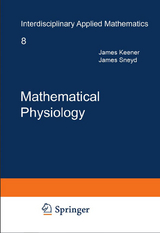A Mathematical Physiology
Seiten
1998
|
1998. Corr. 2nd Printing ed.
Springer-Verlag New York Inc.
978-0-387-98381-3 (ISBN)
Springer-Verlag New York Inc.
978-0-387-98381-3 (ISBN)
- Titel erscheint in neuer Auflage
- Artikel merken
Zu diesem Artikel existiert eine Nachauflage
Offers an introduction into physiology using the tools and perspectives of mathematical modeling and analysis. This book describes ways in which mathematical theory may be used to give insights into physiological questions and how physiological questions can in turn lead to new mathematical problems.
"Mathematical Physiology" provides an introduction into physiology using the tools and perspectives of mathematical modeling and analysis. It describes ways in which mathematical theory may be used to give insights into physiological questions and how physiological questions can in turn lead to new mathematical problems. The book is divided in two parts, the first dealing with the fundamental principles of cell physiology, and the second with the physiology of systems. In the first part, after an introduction to basic biochemistry and enzyme reactions, the authors discuss volume control, the membrane potential, ionic flow through channels, excitability, calcium dynamics, and electrical bursting. This first part concludes with spatial aspects such as synaptic transmission, gap junctions, the linear cable equation, nonlinear wave propagation in neurons, and calcium waves.In the second part, the human body is studied piece by piece, beginning with an introduction to electrocardiology, followed by the physiology of the circulatory system, blood muscle, hormones, and kidneys. Finally, the authors examine the digestive system and the visual system, ending with the inner ear.
This book will be of interest to researchers, to graduate students and advanced undergraduate students in applied mathematics who wish to learn how to build and analyze mathematical models and become familiar with new areas of applications, as well as to physiologists interested in learning about theoretical approaches to their work. "Mathematical Reviews, 2000" - 'This is neither a physiology book nor a mathematics book, but it is probably the best book ever written on the interdisciplinary field of mathematical physiology, i.e. mathematics applied to modelling physiological phenomena. The book is highly recommended to anybody interested in mathematical or theoretical physiology'.
"Mathematical Physiology" provides an introduction into physiology using the tools and perspectives of mathematical modeling and analysis. It describes ways in which mathematical theory may be used to give insights into physiological questions and how physiological questions can in turn lead to new mathematical problems. The book is divided in two parts, the first dealing with the fundamental principles of cell physiology, and the second with the physiology of systems. In the first part, after an introduction to basic biochemistry and enzyme reactions, the authors discuss volume control, the membrane potential, ionic flow through channels, excitability, calcium dynamics, and electrical bursting. This first part concludes with spatial aspects such as synaptic transmission, gap junctions, the linear cable equation, nonlinear wave propagation in neurons, and calcium waves.In the second part, the human body is studied piece by piece, beginning with an introduction to electrocardiology, followed by the physiology of the circulatory system, blood muscle, hormones, and kidneys. Finally, the authors examine the digestive system and the visual system, ending with the inner ear.
This book will be of interest to researchers, to graduate students and advanced undergraduate students in applied mathematics who wish to learn how to build and analyze mathematical models and become familiar with new areas of applications, as well as to physiologists interested in learning about theoretical approaches to their work. "Mathematical Reviews, 2000" - 'This is neither a physiology book nor a mathematics book, but it is probably the best book ever written on the interdisciplinary field of mathematical physiology, i.e. mathematics applied to modelling physiological phenomena. The book is highly recommended to anybody interested in mathematical or theoretical physiology'.
Preface.-Acknowledgements.- I. Cellular Physiology:1 Biochemical Reactions.2 Cellular Homeostasis.3 Membrane Ion Channels.4 Excitability.5 Calcium Dynamics.6 Bursting Electrical Activity.7 Intercellular Communication.8 Passive Electrical Flow in Neurons.9 Nonlinear Wave Propagation.10 Wave Propagation in Higher Dimensions.11 Cardiac Propagation.12 Calcium Waves.13 Regulation of Cell Function.-II. Systems Physiology:14 Cardiac Rhythmicity.15 The Circulatory System.16 Blood.17 Respiration.18 Muscle.19 Hormone Physiology.20 Renal Physiology.21 The Gastrointestinal System.22 The Retina and Vision. 23 The Inner Ear.-Appendix: Units and Physical Constants.-References.-Index.
| Erscheint lt. Verlag | 1.6.2001 |
|---|---|
| Reihe/Serie | Interdisciplinary Applied Mathematics ; Vol.8 |
| Zusatzinfo | 347 illus. |
| Verlagsort | New York, NY |
| Sprache | englisch |
| Einbandart | gebunden |
| Themenwelt | Mathematik / Informatik ► Mathematik |
| Studium ► 1. Studienabschnitt (Vorklinik) ► Physiologie | |
| Naturwissenschaften ► Biologie | |
| ISBN-10 | 0-387-98381-3 / 0387983813 |
| ISBN-13 | 978-0-387-98381-3 / 9780387983813 |
| Zustand | Neuware |
| Haben Sie eine Frage zum Produkt? |
Mehr entdecken
aus dem Bereich
aus dem Bereich





